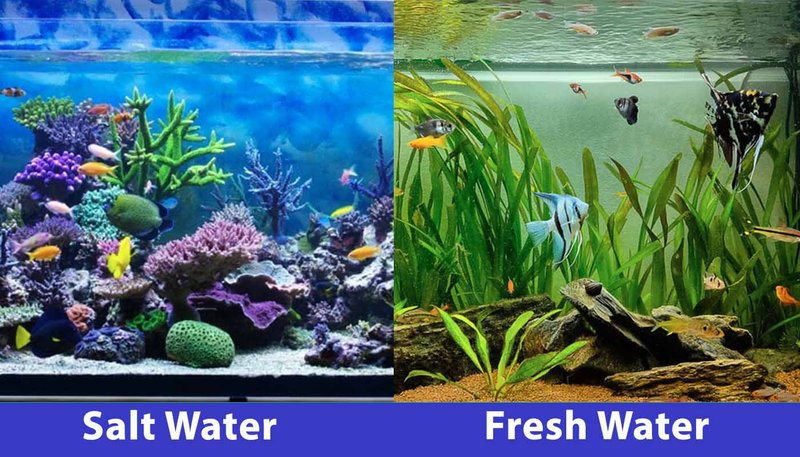
Imagine stepping into a lush forest filled with greenery when you think of freshwater aquariums. They’re often easier to set up and maintain, making them a great option for beginners. On the other hand, saltwater aquariums can feel like diving into a tropical paradise, but they often require a bit more expertise and dedication. Let’s dive into the nitty-gritty of what sets these two types of tanks apart, so you can better decide which one might be the best fit for you.
Understanding the Basics: Freshwater Aquariums
Freshwater aquariums are typically home to fish and plants that thrive in non-salty water. This makes them an excellent choice for beginners. The water here is usually softer and less complicated to maintain. You can find a variety of fish that are colorful and easy to care for, like guppies, tetras, or bettas. Freshwater setups can be quite flexible in terms of design and plant life, allowing you to create a peaceful underwater landscape.
Setting up a freshwater aquarium generally requires less equipment. You’ll need a tank, filter, heater, and substrate, along with food and maybe some decorations. The whole process can feel like setting up a small garden. You might enjoy arranging beautiful plants or adding a decorative castle. Plus, freshwater fish tend to be more forgiving of beginner mistakes, which is a huge plus when you’re just starting out.
Maintenance is another plus point for freshwater tanks. Regular water changes, cleaning the substrate, and checking water parameters can usually be done in a couple of hours each month. You might find yourself peering into your tank, watching your fish swim, and feeling proud of your little ecosystem.
The Magic of Saltwater Aquariums
Saltwater aquariums transport you into a different realm. The colors, shapes, and varieties of marine life found in these tanks can be breathtaking. You might find yourself mesmerized by clownfish darting among anemones or vibrant parrotfish nibbling on coral. Setting up a saltwater tank can be akin to creating an art piece that captures the beauty of the ocean.
That said, saltwater aquariums often come with a steeper learning curve. You’ll need to monitor salinity levels, pH, and specific gravity, which can feel overwhelming at first. The equipment you require can also be more extensive, including a protein skimmer or specialized lighting to mimic the ocean’s natural environment. It’s almost like you’re not just maintaining a tank but nurturing a mini ocean.
While a saltwater tank can be more challenging to keep stable, the payoff is absolutely worth it. If you invest the time and care, you can create a stunning display that showcases a slice of marine biodiversity right in your living room.
Cost Considerations: What’s Your Budget?
When weighing the costs of freshwater versus saltwater aquariums, one key difference stands out. Freshwater tanks are generally more affordable to set up. The fish themselves typically cost less, and the equipment is more budget-friendly. You might find that you can easily set up a beautiful freshwater aquarium for a few hundred dollars or less.
Saltwater aquariums, on the other hand, can be a bit of a financial commitment. You’ll need to consider the price of live rock, higher-quality equipment, and often more expensive fish and corals. It’s not unusual for beginners to spend over a thousand dollars on a fully equipped marine setup. So, if you’re working with a budget, freshwater might be the way to go.
However, think about the long-term enjoyment and satisfaction. If you’re passionate about marine life and willing to invest, a saltwater tank can provide an incredible return on investment in terms of beauty and wonder.
Fish Compatibility: What Can Live Together?
When it comes to fish compatibility, freshwater aquariums generally offer a broader range of community-building options. You can mix various species without worrying too much about aggression, though you still need to consider tank mates. For example, peaceful species like neon tetras can happily coexist with other gentle fish. So, if you enjoy watching a variety of fish interact together, freshwater might be a great choice.
Saltwater fish, however, can be a bit more territorial and aggressive. You have to do your homework when selecting species, as some may not get along with others. For instance, a clownfish may thrive in a tank with anemones, but throw in a more aggressive fish, and you might have a problem. Researching the right combinations is key, and it’s part of the excitement of creating a unique marine community.
This compatibility factor is crucial for ensuring your fish live harmoniously. You might even find yourself diving deep into the fascinating world of fish behaviors and interactions, further enriching your aquarium experience.
Water Chemistry: The Science Behind Your Tank
One area where saltwater and freshwater tanks diverge significantly is in their water chemistry. Freshwater is generally more forgiving when it comes to monitoring parameters. The primary focus is often on temperature, pH, and ammonia levels. These can typically be maintained relatively easily, making for a more laid-back maintenance routine.
Saltwater tanks require a closer eye on a variety of factors, such as salinity, pH, temperature, and nitrates. This means investing in a reliable testing kit to keep track of these values. Understanding how these factors interact can feel daunting, but it’s essential for creating a healthy environment. If you’re up for a bit of science, it can actually be pretty rewarding to establish an ideal balance that supports thriving marine life.
Remember, maintaining a stable environment is crucial in both types of tanks. Making sure to regularly check water parameters will help prevent any surprises when it comes to your fish’s health.
Environmental Aspects: Creating a Healthy Habitat
Creating a healthy environment in your aquarium goes beyond just water chemistry. Freshwater tanks often focus on plant life, which not only beautifies the tank but also helps maintain water quality. Adding plants like java ferns or anubias can provide your fish with shelter and create a more natural ecosystem.
In saltwater tanks, you might think about incorporating live rock and corals. These not only add to the aesthetic appeal but also provide essential habitats for the fish. The biodiversity of a saltwater aquarium can be remarkable, but it does require more careful consideration of the types of corals and rocks you introduce.
In both scenarios, you need to think about lighting as well. Freshwater tanks typically don’t require special lighting, while saltwater tanks often benefit from high-intensity lighting to support coral growth. So, doing a little homework can go a long way in creating a thriving environment for your aquatic friends.
Final Thoughts: Which One is Right for You?
Ultimately, the choice between saltwater and freshwater aquariums hinges on your personal interests, budget, and commitment level. If you’re looking for a relaxing hobby that’s easier to manage, a freshwater tank might be your best bet. You’ll find plenty of colorful fish and plants to create your peaceful underwater oasis.
However, if you’re excited about the ocean’s mysteries and willing to invest time and money into maintaining a beautiful marine environment, then a saltwater aquarium can be an incredibly rewarding endeavor. The vibrant colors and fascinating interactions among marine life can turn your living space into a stunning coastal retreat.
Regardless of your choice, both freshwater and saltwater aquariums offer a unique window into the aquatic world. Whether you prefer the calm serenity of a freshwater tank or the vibrant chaos of a saltwater setup, you’re in for a treat as you immerse yourself in the joys of aquaristics.

